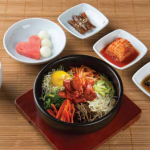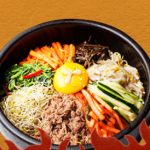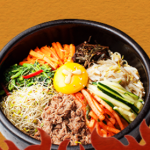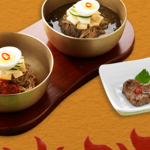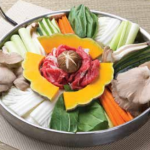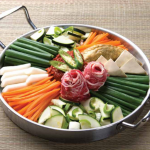Introduction
안녕하세요 (Annyeonghaseyo)! Are you ready to embark on a gustatory adventure that will leave your taste buds salsa dancing and your belly singing? Well, look no further than the vibrant world of Korean cuisine. This delightful culinary extravaganza combines mouth-watering flavors, ingenious techniques, and a touch of K-pop pizzazz. In this article, we’ll tantalize your food-loving soul with a humorous look at some iconic Korean dishes that will have you reaching for your chopsticks and saying, “Jeogiyo (excuse me), can I have seconds, please?”
Body
Bibimbap: The Ultimate Rice Bowl Symphony
When it comes to iconic Korean dishes, Bibimbap takes the center stage faster than a K-pop sensation’s hit single climbing the charts. Imagine a harmonious medley of rice, perfectly cooked vegetables, juicy slices of meat, and a fried egg beaming like the sun. This culinary masterpiece is then serenaded with a melodic orchestra of spicy gochujang sauce and sesame oil. So, the next time someone asks you how to pronounce Bibimbap, just answer, “Delicious!”
Kimchi: The Fermented Fiery Temptress
Kimchi, oh Kimchi! This fiery, fermented temptress is the queen of Korean cuisine. With its striking red color and that tangy, piquant kick, kimchi has a flavor that is as bright and bold as a K-drama plot twist–never predictable but always addictive. Whether enjoying it on its own, adding it to soups, or using it to spice up a stew, this probiotic-packed delight will keep your taste buds on their toes, begging for more.
Bulgogi: The K-pop Star of Barbecued Meats
Move over BTS and Blackpink, because Bulgogi is the true K-pop star of barbecued meats. Picture succulent, marinated slices of beef or pork sizzling on a grill, filling the air with an aroma that could awaken the appetite of even the sleepiest K-drama fan. The tender meat, sweet and savory marinade, and a touch of garlic unite to create a taste explosion that’ll have you singing “Gochu-jang, Gochu-jang!” at the top of your lungs.
Tteokbokki: The Spicy Rice Cake Roller Coaster
Hold on tight, folks, because Tteokbokki is about to take your taste buds on a spicy, saucy roller coaster ride. This popular street food dish features chewy rice cakes swimming in a fiery chili paste sauce. It’s the kind of dish that’ll make your eyes water, your nose tingle, and your mouth dance with delight – all at the same time. So, if you’re craving an adventure that comes with a side of heat, Tteokbokki is your ticket.
Japchae: The Glass Noodle Magician
Abracadabra! With a wave of a spatula, Japchae transforms ordinary glass noodles into a mesmerizing dish that’ll leave you spellbound. Prepared with an array of colorful vegetables, succulent meat, and a sprinkle of sesame seeds, this stir-fried wonder has a texture that’s silky smooth, and a flavor profile that’s anything but ordinary. Japchae is like a magician’s trick – it disappears from your plate faster than you can say “맛있어요 (Mashiseoyo)!”
Conclusion
한 식사를 크게 하면, 생각보다 행복할 것입니다 (A big meal will make you happier than you think). Korean cuisine offers a culinary adventure that combines bold flavors, vibrant colors, and a dash of quirky humor. From the harmonious symphony of Bibimbap to the fiery temptations of Kimchi, each dish is a gateway to an enchanting world of delightful flavors. So, grab your chopsticks, embrace the K-wave, and embark on a gastronomic journey that will leave you both satisfied and entertained!
FAQ (Frequently Asked Questions)
Q1: Are Korean dishes always spicy?
A1: While Korea is famous for its love of spicy flavors, not all Korean dishes have the same heat level. Many dishes, such as Bibimbap or Japchae, can be tailored to your desired level of spiciness.
Q2: What makes Kimchi so special?
A2: Kimchi is not only packed with vibrant flavors but also boasts numerous health benefits. It is rich in vitamins, minerals, and probiotics, which aid digestion and support a healthy immune system.
Q3: Is it rude to leave food on the plate in Korean culture?
A3: In Korean culture, leaving a small amount of food on your plate is considered polite, as it signifies that you are satisfied. However, clearing your plate entirely may signal that you are still hungry.
Q4: Can vegetarians enjoy Korean cuisine?
A4: Absolutely! While meat plays a significant role in many Korean dishes, there are plenty of veggie-friendly options available. Dishes like Bibimbap or Japchae can easily be made without meat.
Q5: Why is the presentation of Korean cuisine so important?
A5: Koreans believe that visually appealing food enhances the overall dining experience. The vibrant colors and beautiful arrangement of ingredients in Korean dishes reflect the country’s emphasis on harmonious balance and attention to detail.

